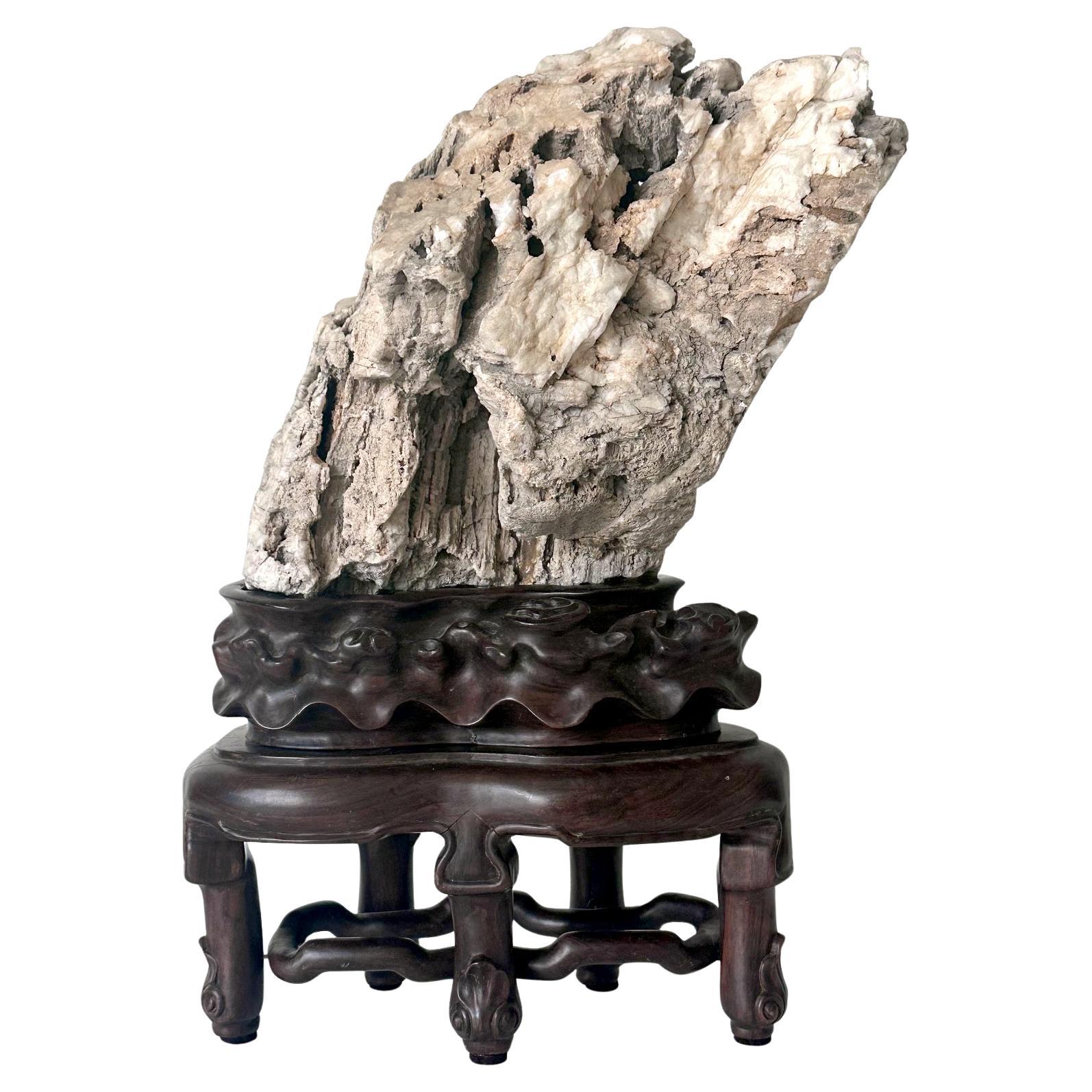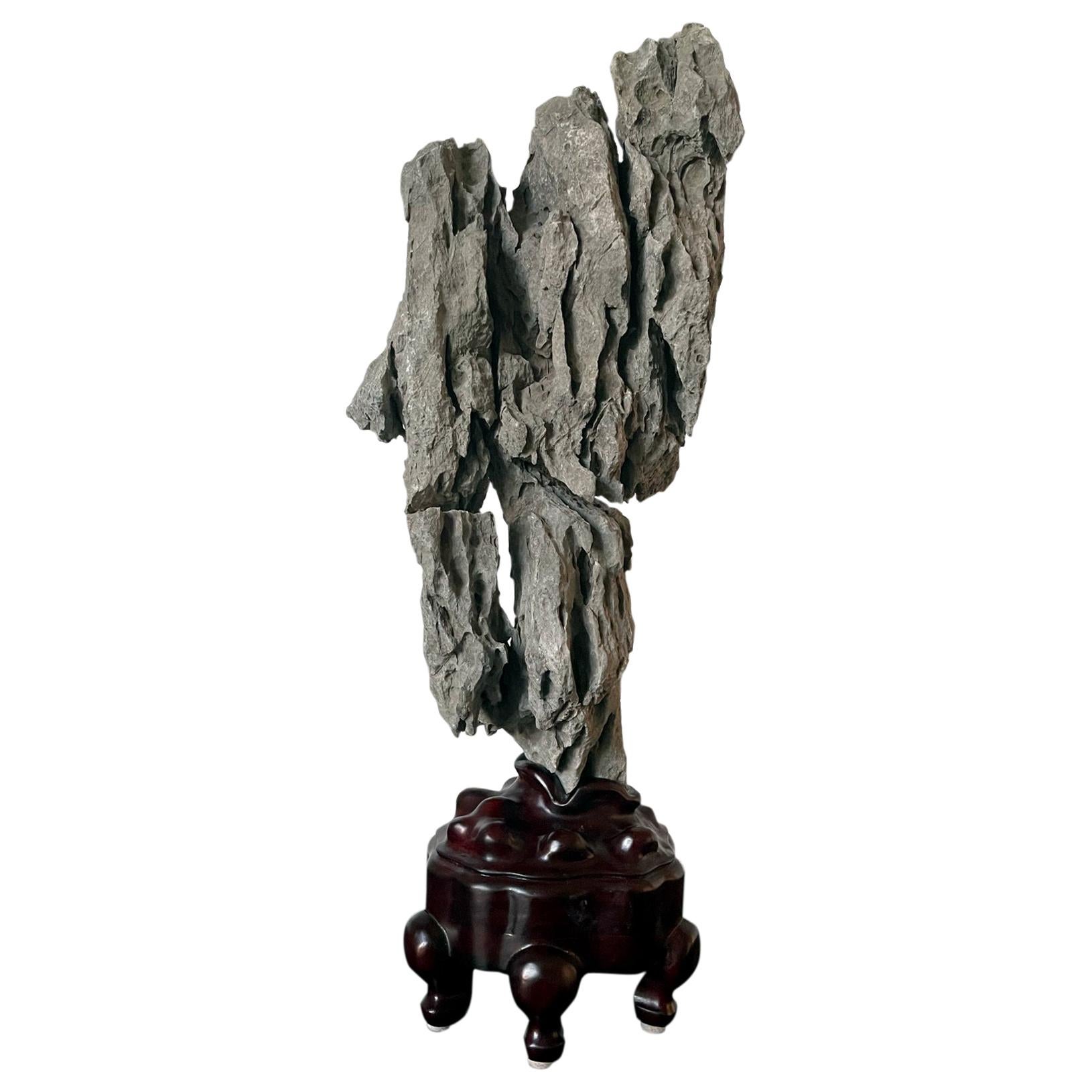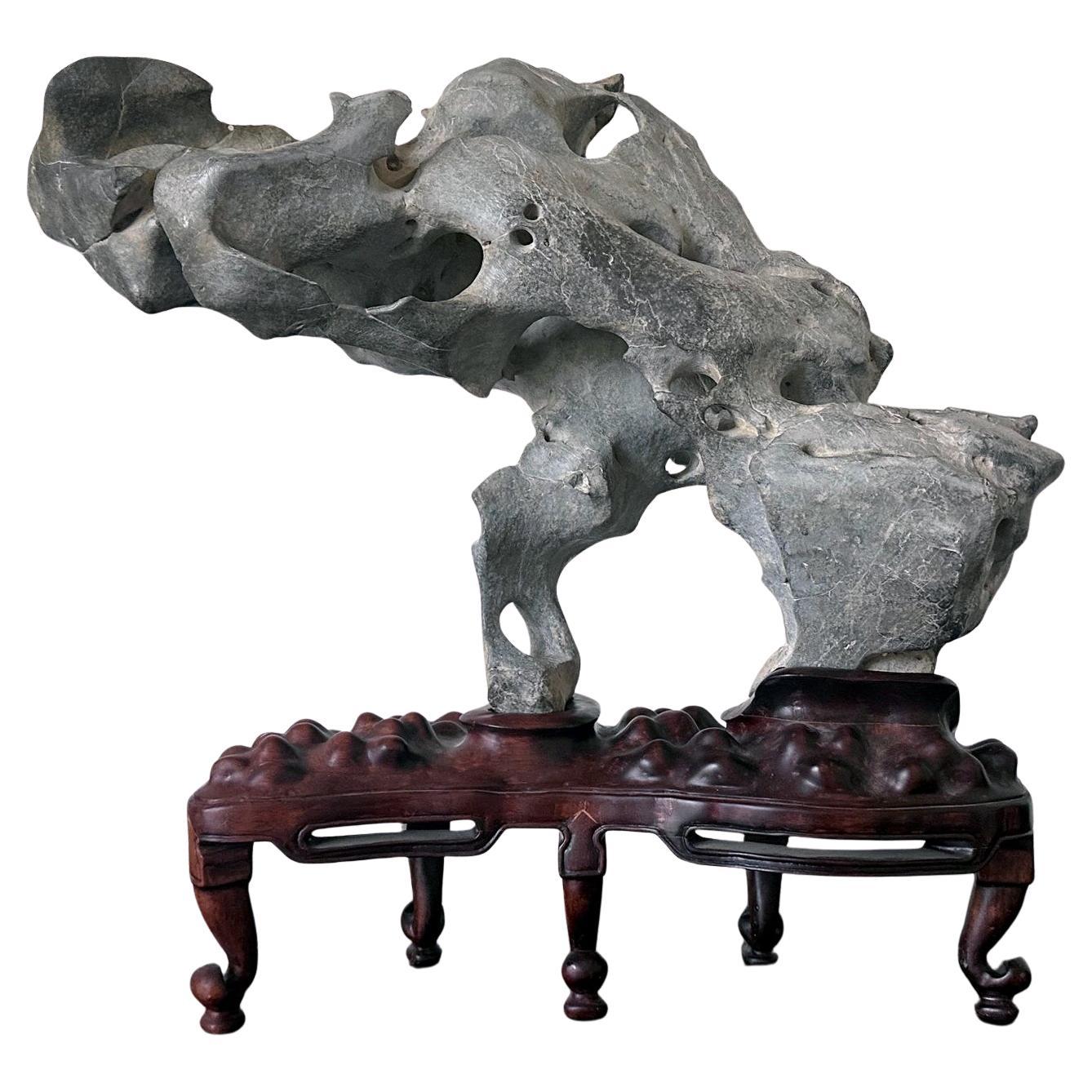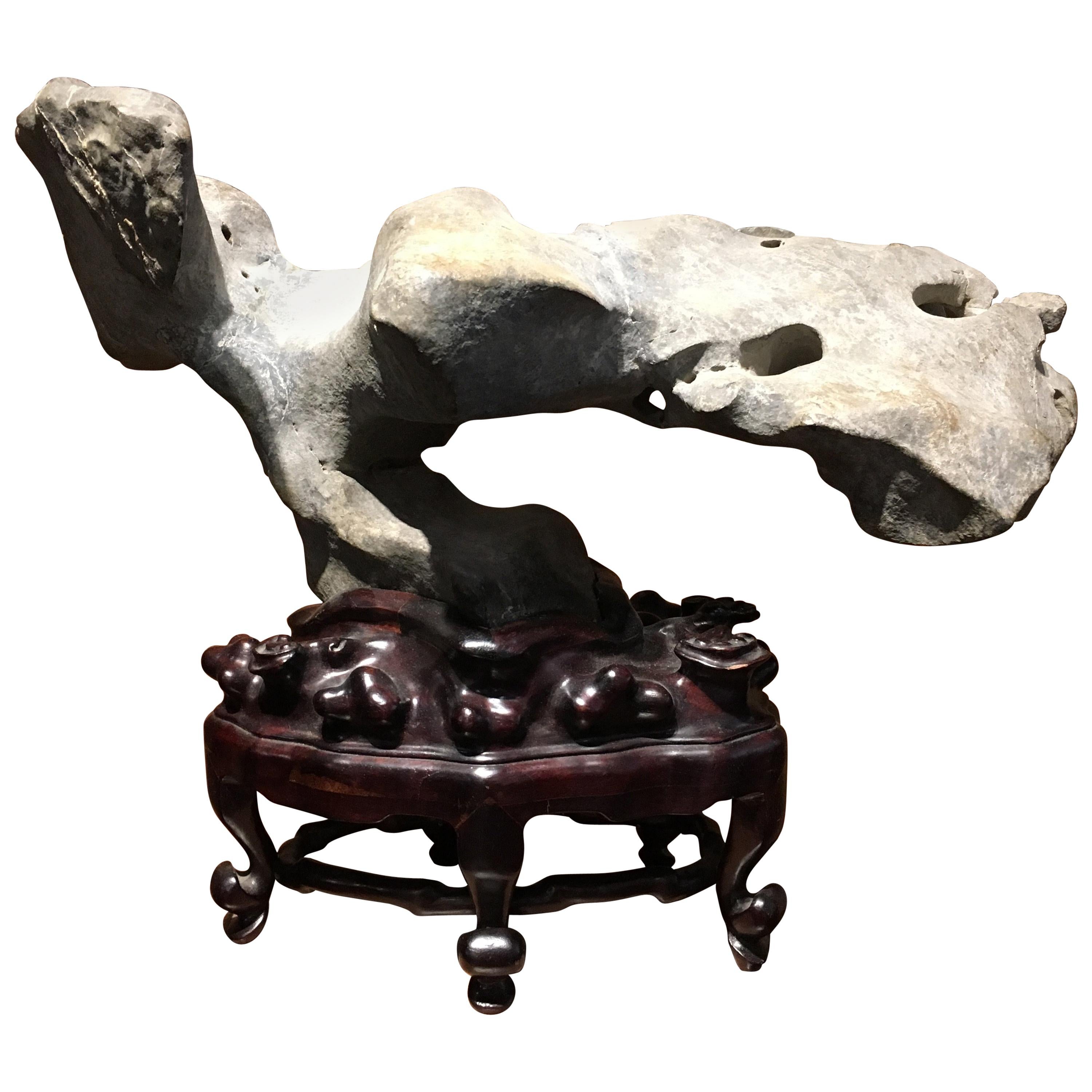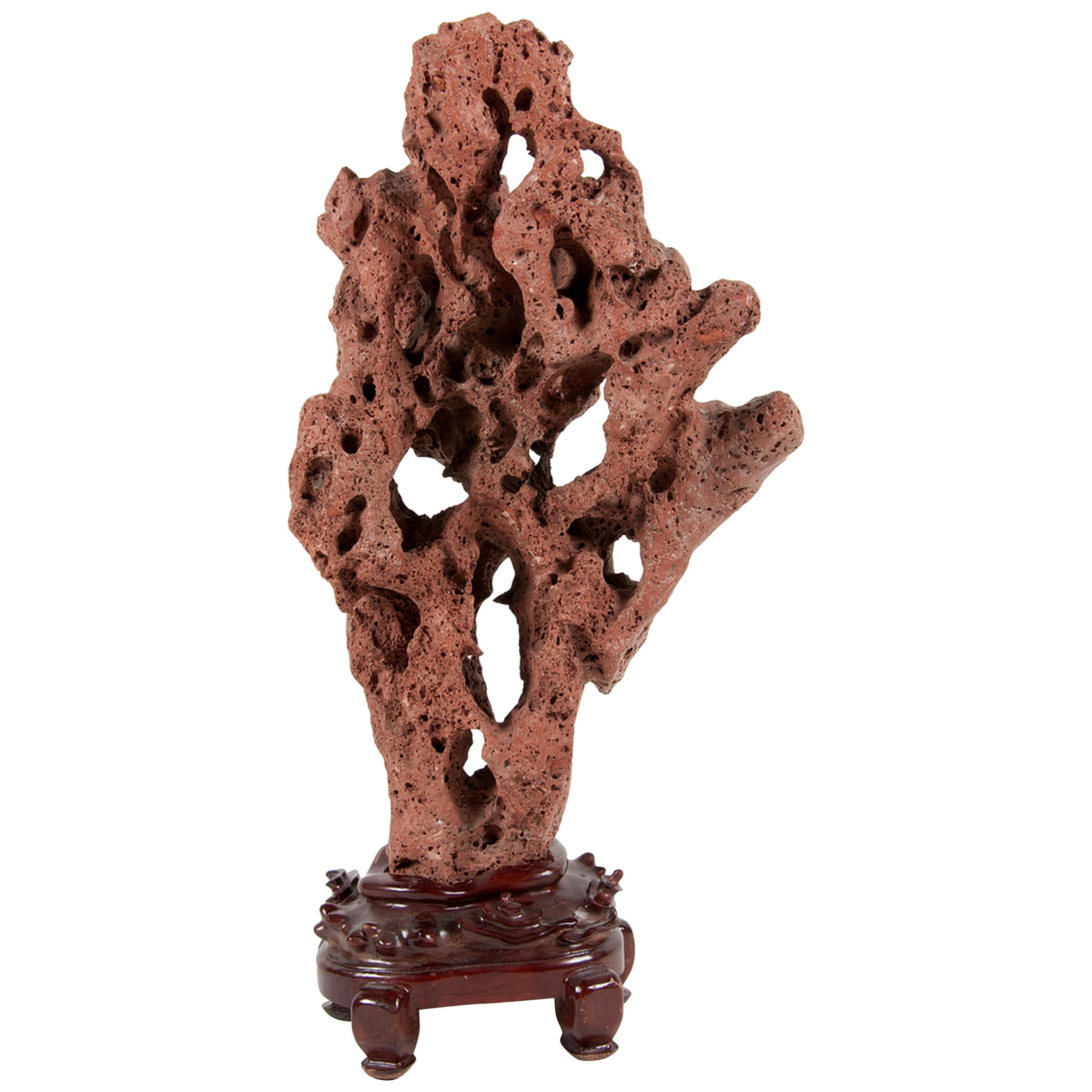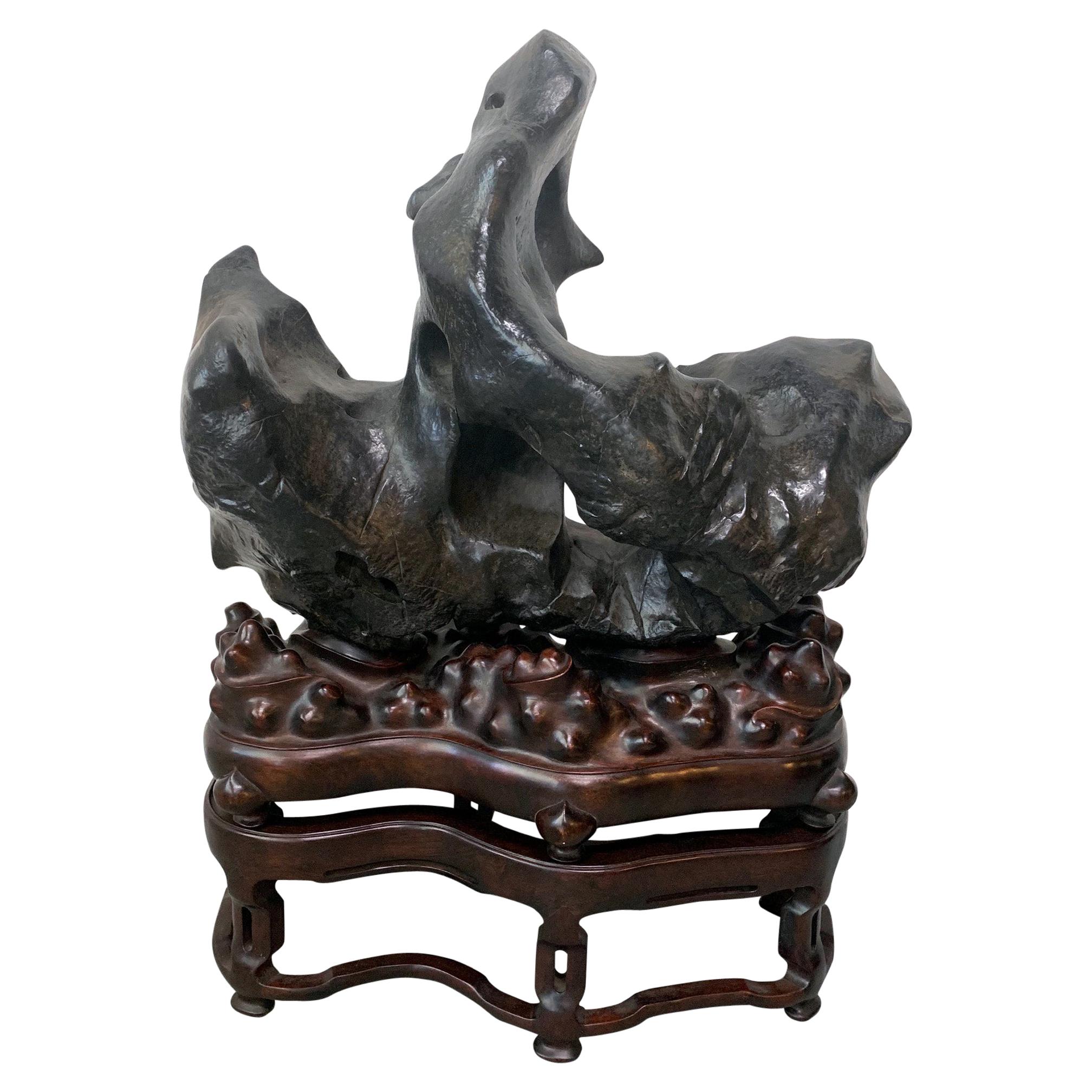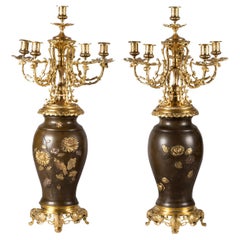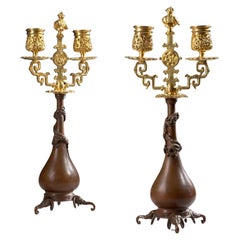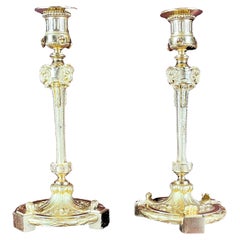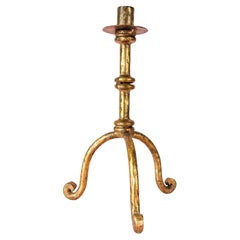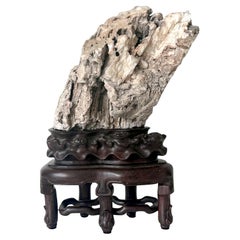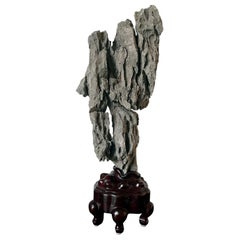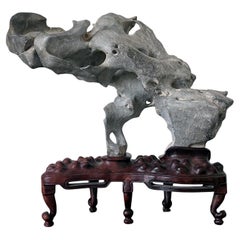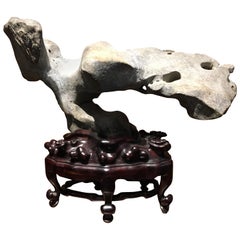Objekte ähnlich wie Scholar's Stone / “Scholar's Rock” Lingbi (灵璧石), China, Qing Dynasty
Möchten Sie mehr Bilder oder Videos?
Zusätzliche Bilder oder Videos von dem*der Anbieter*in anfordern
1 von 21
Scholar's Stone / “Scholar's Rock” Lingbi (灵璧石), China, Qing Dynasty
18.900 €Einschließlich MwSt.
Angaben zum Objekt
An exceptional scholar's rock lingbi (灵璧石), traditionally intended for Chinese scholars, on a very elaborate Qing period wooden base. It is presented with the larger end above the smaller, a position known in China as yun tou, yu jiao or 'head in the clouds, feet in the rain', evoking an auspicious rising cloud of smoke. Its particular shape allows it to be observed both from the front and from the side.
The lingbi stone, a dark gray/black lustrous veined with white, is particularly comparable to a copy sold by Christies' in 2015 in Hong Kong (lot 3005, sale of December 2, 2015).
Dimensions: 56 cm high by 28 cm wide (the stone itself is 38 cm high).
Gongshi (Chinese: 供石), also called scholar's stones or observation stones, are natural or shaped rocks, traditionally appreciated by Chinese scholars and displayed in their workshops.
As early as the Neolithic period, nearly 7,000 years ago, stones of this type have been discovered buried in tombs. However, it wasn't until the late Tang Dynasty (618-907) that scholarly stones became a truly collectible item. Their influence on Chinese literature began to be felt a little later: "Mi Fu (1051-1107) and others composed essays on stones," explains Christie's specialist Pola Antebi, "and Du Wan (12th century) compiled the first comprehensive catalog of stones, 'Yunlin shipu,' testifying to the growing appreciation of these stones."
As early as the Song Dynasty, naturally eroded stones were collected and displayed for viewing. By the 17th century, some stones were considered important and respected enough to be the subject of portraits. In his mid-19th-century work, Tanshi (Conversations on Rocks), Liang Jiutu argued that "in collecting, it is the choice of stones that is paramount." If the stone does not resemble a painting created by the forces of nature, it should not be chosen."
During the Tang dynasty, four important qualities were recognized for stones: fineness (瘦 shòu), openness (透 tòu), perforations (漏 lòu), and wrinkling (皺 zhòu). With these qualities, the observer can admire the strength of the contours, perhaps seeing a mountain ridge or a cloud rising within the amorphous mass. The stone can be displayed on a specially carved rosewood base. Scholar's stones are a traditional subject of Chinese painting.
Rocks are classified according to their origin. The most venerated sites are (i) the Lingbi Stone (Lingbishi) (灵璧石) of Lingbi, Anhui Province, (ii) the Taihu Stone (Taihushi) (太湖石) of Lake Tai, Jiangsu Province, and (iii) the Yingde Stone (Yingshi or Yingdeshi) (英石 or 英德石) of Yingde, Guangdong Province. Besides small table specimens, many monumental boulders are found in gardens throughout China, including the "auspicious cloud peak" in the Lingering Garden in Suzhou.
Robert D. Mowry, a distinguished expert and curator emeritus of the Harvard Art Museum, describes them as "stones prized by Chinese scholars, displayed in the rarefied atmosphere of their studios." The Chinese scholar drew his inspiration from nature; He didn't venture into nature to paint or compose poems, explains Christie's specialist Pola Antebi. Instead, he worked in the privacy of his studio and drew inspiration from these "mountain depictions."
The stones were often brought to scholars from remote areas, with the finest coming from riverbeds or mountains. Some of the most valuable examples came from Lingbi, in Anhui Province, northern China. "Because of their density, Lingbi stones are naturally resonant," explains Mowry. "The best Lingbi stones are deep black; often slightly textured, their surfaces appear wet and shiny."
- Maße:Höhe: 56 cm (22,05 in)Breite: 28 cm (11,03 in)Tiefe: 20 cm (7,88 in)
- Stil:Qing-Dynastie (Aus dem Zeitalter)
- Materialien und Methoden:
- Herkunftsort:
- Zeitalter:
- Herstellungsjahr:1850-1911
- Zustand:Abnutzung dem Alter und der Nutzung entsprechend.
- Anbieterstandort:MOUGINS, FR
- Referenznummer:1stDibs: LU10660247021602
Anbieterinformationen
Neu bei 1stDibs
In den letzten sechs Monaten beigetreten.
Noch keine Bewertungen
Geprüfte*r Anbieter*in
Jede*r Anbieter*in erfüllt strenge Standards bezüglich Echtheit und Zuverlässigkeit
1stDibs-Anbieter*in seit 2025
- VersandAngebot wird abgerufen …Versand von: MOUGINS, Frankreich
- Rückgabebedingungen
Einige Inhalte dieser Seite wurden automatisch übersetzt. Daher kann 1stDibs nicht die Richtigkeit der Übersetzungen garantieren. Englisch ist die Standardsprache dieser Website.
Authentizitätsgarantie
Im unwahrscheinlichen Fall eines Problems mit der Echtheit eines Objekts kontaktieren Sie uns bitte innerhalb von 1 Jahr für eine volle Rückerstattung. DetailsGeld-Zurück-Garantie
Wenn Ihr Objekt nicht der Beschreibung entspricht, beim Transport beschädigt wurde oder nicht ankommt, kontaktieren Sie uns bitte innerhalb von 7 Tagen für eine vollständige Rückerstattung. DetailsStornierung innerhalb von 24 Stunden
Sie können Ihren Kauf jederzeit innerhalb von 24 Stunden stornieren, ohne jegliche Gründe dafür angeben zu müssen.Geprüfte Anbieter*innen
Unsere Anbieter*innen unterliegen strengen Dienstleistungs- und Qualitätsstandards, wodurch wir die Seriosität unserer Angebote gewährleisten können.Preisgarantie
Wenn Sie feststellen, dass ein*e Anbieter*in dasselbe Objekt anderswo zu einem niedrigeren Preis anbietet, werden wir den Preis entsprechend anpassen.Zuverlässige weltweite Lieferung
Unsere erstklassigen Versandunternehmen bieten spezielle Versandoptionen weltweit, einschließlich individueller Lieferung.Mehr von diesem*dieser Anbieter*in
Alle anzeigenPair Of Aesthetic/Japonism Style Candelabras - Meiji with Shakudo Decoration
A beautiful and very large pair of Meiji period Japanese bronze vases with brown patina and caved design with applied gilt and silver bronze inserts representing birds and insects fl...
Kategorie
Antik, Spätes 19. Jahrhundert, Französisch, Japonismus, Kandelaber
Materialien
Bronze
Pair of Japanese-style Candlesticks by Ferdinand Barbedienne and Edouard Lievre.
Von Ferdinand Barbedienne, Edouard Lievre
Exceptional pair of candlesticks with ovoid body and domed belly in chiseled bronze with brown patina on which a dragon coils, resting on tripod bases with 3 stylized elephant heads ...
Kategorie
Antik, Spätes 19. Jahrhundert, Französisch, Japonismus, Kandelaber
Materialien
Bronze
Maison Marnyhac - Pair Of Candlesticks - Gilt & Chiseled Bronze - 19th Century
Von Maison Marnyhac 1
A rare pair of candle-holders in chiseled and gilt bronze in Louis XVI / 18th century style, signed by Maison Marnyhac and manufactured in the late 19th century.
Rich ornamentation ...
Kategorie
Antik, Spätes 19. Jahrhundert, Französisch, Louis XVI., Kerzenständer
Materialien
Bronze
Brutalist Candleholder - Gilt & Patinated Bronze - 1950s
A candle-holder in wrought iron. It is plated with gold leaf and patinated, resting on three curved feet.
This piece is in Brutalist style and was manufactured in the 1950s. It comp...
Kategorie
Vintage, 1950er, Französisch, Brutalismus, Kerzenständer
Materialien
Bronze
Pierre Casenove for Fondica - Gilt Bronze High Table Lamp - 1980s
Von Pierre Casenove
A high table lamp in gilt bronze with its original shade and in perfect condition, resting on four feet.
Signed on one foot by Pierre Casenove and on another by Fondica, as well as ...
Kategorie
Vintage, 1980er, Französisch, Tischlampen
Materialien
Bronze
Roger Capron - Rare Wall Flower Vase
Von Roger Capron
A rare wall flower vase by Roger Capron (1922-2006) in white ceramic with patterned design created using paraffin during the glazing process, as well as a black / yellow painted patt...
Kategorie
Vintage, 1960er, Französisch, Vasen
Materialien
Keramik
Das könnte Ihnen auch gefallen
Seltener chinesischer Xuan Scholar Stone auf Display Stand
Ein seltener chinesischer Gelehrtenstein des Xuan-Typs auf einem geschnitzten Holzständer aus der Qing-Dynastie des 19. Der Xuan-Stein wurde traditionell in Xuan Zhou in der Provinz ...
Kategorie
Antik, 19. Jahrhundert, Chinesisch, Qing-Dynastie, Objekte von Gelehrten
Materialien
Stein
Außergewöhnlicher chinesischer Gelehrter Rock Ying Stone auf Stand
Der hier angebotene chinesische Gelehrtenstein ist ein wunderbares Beispiel für Ying (auch als Yingde-Stein bekannt), eine seltenere Art als Lingbi oder Taihu. Die graue Pflanze hat ...
Kategorie
Antik, 19. Jahrhundert, Chinesisch, Qing-Dynastie, Objekte von Gelehrten
Materialien
Stein
Außergewöhnliche chinesische Taihu Scholar Stone Rare Form auf Display Stand
Ein atemberaubender Taihu-Gelehrter Stein in einer ungewöhnlichen horizontalen, ausgewogenen Form, der auf einem maßgefertigten Holzständer thront. Der fast rein grauweiße Stein weis...
Kategorie
Antik, 19. Jahrhundert, Chinesisch, Qing-Dynastie, Objekte von Gelehrten
Materialien
Stein
Chinesischer grauer Lingbi-Stipendiatstein, frühes 20. Jahrhundert
Ein fantastischer chinesischer Gelehrtenstein, Gongshi genannt, aus grauem Lingbi-Kalkstein, montiert auf einem Hartholzständer, spätes Qing oder frühe Republik, frühes 20.
Der Ste...
Kategorie
Frühes 20. Jahrhundert, Chinesisch, Qing-Dynastie, Objekte von Gelehrten
Materialien
Kalkstein
Großer chinesischer Scholar Stone Seltener roter Taihu-Felsen auf Display Stand
Ein großer und dramatischer chinesischer Gongshi (bekannt als Meditationsstein oder Geisterstein) aus Taihu (Tai-See) balanciert auf einem Ausstellungsständer. Dieses Gelehrtengestei...
Kategorie
Antik, 19. Jahrhundert, Chinesisch, Chinesischer Export, Objekte von Gel...
Materialien
Stein
Großer spektakulärer chinesischer Lingbi Gelehrter Stein auf Stand
Einer der optisch beeindruckendsten chinesischen Gelehrtensteine (auch bekannt als Gong Shi, Meditationsstein und Spirit Rock), die wir je im Angebot hatten. Ein massiver Block eines...
Kategorie
Antik, 19. Jahrhundert, Chinesisch, Chinoiserie, Objekte von Gelehrten
Materialien
Stein
